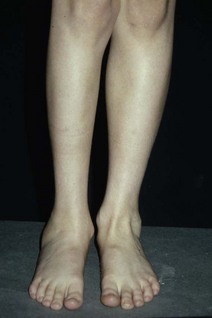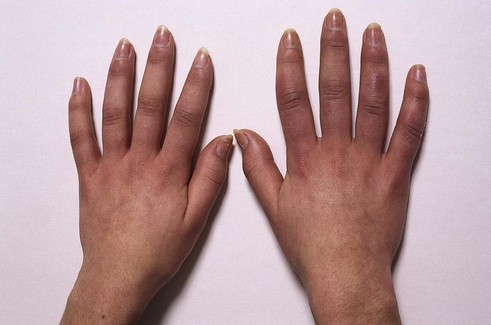27 Arthritis in children
Cases relevant to this chapter
Essential facts
1. Juvenile idiopathic arthritis (JIA) affects 0.1% of the population.
2. The onset of JIA can be: polyarticular (five or more joints at presentation), oligoarticular (fewer than five joints at presentation) or systemic (features such as fever and rash at presentation).
3. All children with oligoarticular JIA should be considered to be at risk of developing anterior uveitis, which is asymptomatic and must be screened for. Uveitis left untreated may lead to blindness.
4. Most children with polyarticular JIA are rheumatoid factor-negative.
5. Typical features of systemic-onset JIA include high spiking fever, a transient episodic erythematous rash, lymphadenopathy, hepatosplenomegaly and pericarditis.
6. The differential diagnosis for systemic JIA includes infection, inflammatory bowel disease and malignancy (especially leukaemia and neuroblastoma).
7. Enthesitis-related JIA, like adult ankylosing spondylitis, is strongly associated with HLA-B27. Children, however, unlike adults, tend to present with an enthesitis or a peripheral oligoarthritis rather than sacro-iliitis.
8. Non-steroidal anti-inflammatory drugs (NSAIDs) are the first-line treatment for most children with JIA, but many will require second-line drugs such as methotrexate, and those who fail to improve will need biologic therapy.
Classification
It is difficult to classify diseases where the precise aetiology is unknown, and JIA is no exception. For arthritis to be classified as ‘juvenile’ rather than ‘adult’, the age of onset must be before 16 years. The duration of the arthritis must be a minimum of 6 weeks in at least one joint, and other causes of arthritis, such as infection, must have been excluded. Broadly, JIA is classified as having three types of onset: polyarticular (five or more joints at presentation), oligoarticular (fewer than five joints at presentation) and systemic (features such as fever and rash at presentation). Presentation in this context means the first 6 months of disease. The most recent classification of idiopathic arthritis in childhood is shown in Box 27.1.
Oligoarticular juvenile idiopathic arthritis
Oligoarthritis is by far the most common subgroup of JIA, accounting for approximately 50% of cases. This type of arthritis may persist with fewer than five joints being affected, or, if more joints become affected after the first 6 months of disease, it is said to have become ‘extended’ oligoarticular JIA, which, not surprisingly, has a worse prognosis than persistent oligoarticular disease. This type of juvenile arthritis most commonly affects young girls, usually aged 4–6 years. The knee is the most common joint to be affected, with wrists and ankles also likely to be involved (Fig. 27.1).
Polyarticular juvenile idiopathic arthritis
Arthritis affecting five or more joints at presentation may be rheumatoid factor (RF) negative or positive (Fig. 27.2). The latter is much less common in children than in adults, and usually affects teenage girls. When it does occur, it behaves very much like adult RA and responds to the same drugs. RF-negative polyarticular disease, like RF-positive arthritis, tends to be symmetrical, but differs in that it may affect the distal interphalangeal joints, which RF-positive disease never does (one of the few ‘nevers’ in medicine!).
< div class='tao-gold-member'>
Stay updated, free articles. Join our Telegram channel

Full access? Get Clinical Tree










